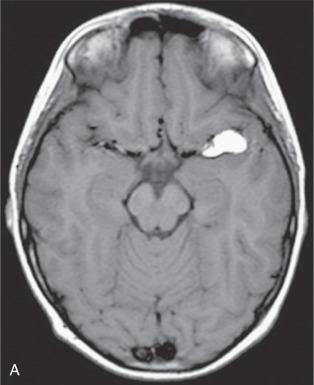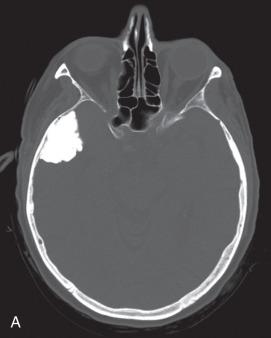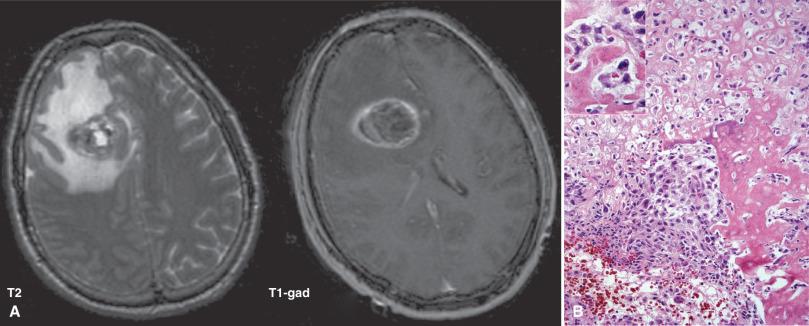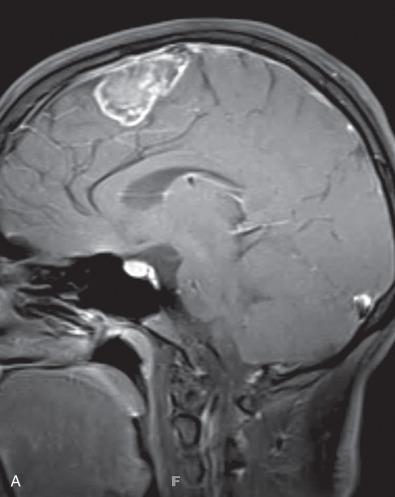Physical Address
304 North Cardinal St.
Dorchester Center, MA 02124
Mesenchymal tumors are believed to originate from precursor mesodermal cells that develop into bone, cartilaginous or connective tissues such as blood vessels, adipocytes, smooth muscle cells, and fibroblasts. Thus, tumors considered in this category cover the entire spectrum of soft tissue and bone tumors. The mesenchymal tumors affecting the central nervous system (CNS) are presumed to arise from the mesodermal cells surrounding the brain parenchyma, mainly from the meninges, vessels, and osseous structures.
While benign mesenchymal tumors outnumber sarcomas in the soft tissue, locally aggressive or frankly malignant mesenchymal tumors are equally common compared to benign neoplasms in the CNS. Historically, the categorization of some mesenchymal tumors in the CNS has differed somewhat from those in the soft tissue.
Sarcomas that arise from extracranial soft tissues and cranial bones are often lumped together along with the intracranial and dural sarcomas. All such tumors can present to a neurosurgeon as brain or spinal cord tumors and therefore are considered in this chapter. While the number of soft tissue and bone tumors in the World Health Organization (WHO) classification is substantial, many of these entities do not occur at an appreciable frequency within the CNS and are not discussed here. Additionally, mesenchymal tumors arising from CNS parenchyma are extraordinarily rare; most so-called CNS sarcomas likely arise from supportive bone and soft tissue elements as well as dura mater. Therefore, this chapter covers the most commonly encountered mesenchymal tumors submitted for pathology by neurosurgeons. Tumors of the peripheral nervous system are covered in Chapter 15 .
A few terms and entities relevant to this chapter deserve special mention. Although gliosarcoma has a partially sarcomatous growth pattern, it is more appropriately considered a neuroepithelial tumor and is not covered in this chapter.
The chapter is arranged into general categories of mesenchymal tumors based on the presumed cell of origin, including adipose, bone, cartilage, notochord, fibroblastic/myofibroblastic, muscle (smooth and skeletal), and vascular elements. Undifferentiated sarcomas, miscellaneous tumors, and tumor-like lesions, as well as radiation-associated sarcomas are also briefly outlined to cover pertinent practical aspects.
The early literature on mesenchymal tumors involving the CNS is highly confusing, and it is virtually impossible to accurately identify the types of sarcomas in many of these reports. As one of many examples, the term gliosarcoma appears to have been used to describe a disparate set of malignant mesenchymal tumors that occurred in or near the brain.
The first WHO classification of CNS tumors in 1979 included a limited number of mesenchymal tumor types scattered within different categories. The classification scheme in 1993 introduced a separate and distinct “mesenchymal–nonmeningothelial tumor” category. Subsequent revisions in 2000 and 2007 retained this approach with the exception that hemangiopericytoma (HPC) was provided its own chapter. The most recent revision of the WHO classification of CNS tumors includes solitary fibrous tumor and hemangiopericytoma within the same entity.
CNS mesenchymal tumors, benign or malignant, are extremely rare and constitute less than 1% of all CNS tumors in the Central Brain Tumor Registry of the United States (CBTRUS). A single institution analysis of sarcomas over a period of 20 years found that primary CNS sarcomas constituted approximately 2% of soft tissue sarcomas identified during the same period. The demographic characteristics of patients vary and depend on the tumor type. Except for rhabdomyosarcoma and other round cell variants, sarcomas are typically encountered in adults and their incidence increases with age. One of the more common etiologic factors for sarcomas of the CNS is radiation of the head and neck region, which is more fully discussed below.
Lipomas are mature masses of adipose tissue involving the intracranial or intraspinal spaces. Intracranial lipomas are uncommon, and their development is poorly understood. They seem to occur more often than liposarcomas. Many lipomas are thought to represent malformative lesions, and the term lipomatous hamartoma is used interchangeably with lipoma. Central nervous system angiolipomas are rare benign vascular and adipocytic neoplasms that may be better classified as hemangiomas; however, given their lipogenic component, they will be discussed in this section. Liposarcomas are exceedingly rare in the CNS, and therefore will not be covered in depth. Most case reports of liposarcomas involving the meninges have represented metastases from soft tissue primaries.
Lipomas are typically midline masses within the cranial cavity. The most common location is the interhemispheric region, followed by the quadrigeminal plate, suprasellar region, cerebellopontine angle, sylvian cisterns, and the lumbosacral spinal cord. A peculiar location is the acoustic nerve, and the rare lipoma of the internal auditory canal can mimic schwannoma. Lipomas are rarely symptomatic, but occasionally cause cerebrospinal fluid (CSF) obstruction or seizures. In addition, some lipomas are associated with other CNS malformations. For example, a midline lipoma or lipomatous hamartoma can accompany partial or complete agenesis of corpus callosum. CNS angiolipomas most commonly occur in the extradural space of the spine or less commonly in the sellar/parasellar regions when intracranial. Liposarcomas predominantly involve the meninges of the cerebral hemispheres.
Lipomatous lesions can be readily recognized radiologically, especially on magnetic resonance imaging (MRI). The typical hyperintense signal on T1-weighted images, coupled with disappearance of the hyperintensity on fat-saturation mode, can highlight lipogenic components of tumors ( Fig. 14.1A ). Nevertheless, rare examples may mimic intra-axial malignancies ( Fig. 14.1B ). Liposarcomas may be more challenging to recognize radiologically, depending on their level of differentiation. The imaging features are often nonspecific, and some high-grade liposarcomas can simulate meningiomas on MRI.

Lipomas consist of mature adipose tissue and occasionally have a thin fibrous capsule ( Fig. 14.1C ). The capsule may not be observed or may be obliterated during processing. Since any lipomatous tissue is abnormal within the cranial cavity, recognition of specific histologic features is of little concern for the diagnosis. Some conventional lipomas contain cartilage (chondrolipomas), bone (osteolipoma), fibrous tissue (fibrolipoma), or skeletal muscle. Angiolipomas are composed of capillaries to larger caliber vessels, more commonly described in the CNS, containing intraluminal thrombi and admixed with mature adipose tissue. The rare liposarcomas that have been reported in the CNS are of the same histologic varieties reported in soft tissue.
Grading of liposarcomas follows the same principles of grading in soft tissue. However, there has been no evidence for the utility of grading liposarcomas in the CNS to date.
Most lipomas are incidental, and many are readily recognized radiologically. Thus, the differential diagnosis only includes entities that cannot be readily excluded on radiologic grounds. Nevertheless, rare intra-axial examples may appear deceptively worrisome or be associated with significant morbidity in an unresectable location (see Fig. 14.1B ). Meningiomas with lipomatous metaplasia (or intracytoplasmic lipid accumulation; see Chapter 13 ) can often be distinguished from true lipomas by the presence of classic meningioma in portions of the tumor. Lipomas with complex elements (lipomatous hamartomas) should be distinguished from teratomas, the latter containing a more complex mixture of all three germinal layers.
Ancillary studies are rarely useful in the diagnosis of lipoma. However, they may be helpful in the diagnosis of liposarcoma.
These lesions are exceedingly rare in the CNS; therefore, the genetics listed are largely extracted from data from soft tissue–based lipogenic neoplasms. While soft tissue lipomas may have a normal karyotype, many show clonal abnormalities, most commonly involving rearrangements of 12q13-15. No association between these anomalies and tumor location has been identified. Genetic alterations in liposarcomas are more complex, with the variants containing unique molecular aberrations.
Most lipomas are recognized incidentally, require no treatment, and are unlikely to cause symptoms. If present, mass effect or obstruction of CSF flow can be alleviated by surgery or shunting. Some examples may be difficult to remove surgically due to their inaccessible locations. Treatment of a liposarcoma in the CNS is far more complex and requires a multimodal approach.
Osteoma is a benign bone-forming tumor that arises from the surface of bone. Osteoid osteoma and osteoblastoma are intraosseous benign bone-forming tumors that are histologically similar. Conventional osteosarcoma is a high-grade malignant neoplasm of bone in which the tumor cells produce osteoid to any extent; they occasionally originate from soft tissue (extraskeletal osteosarcoma). Most osteosarcomas arise de novo (primary) but may also be seen in the setting of Paget disease or following radiation therapy to the region (secondary osteosarcomas).
Osteomas are generally asymptomatic and found incidentally in bones that undergo membranous ossification (as opposed to enchondral ossification); therefore, the most commonly affected bones are those of the calvarium and facial bones, including the jaw. Nevertheless, those with an exophytic intracranial expansion may mimic meningioma both clinically and radiologically ( Fig. 14.2 ). Multiple osteomas are seen in Gardner syndrome, an autosomal dominant inherited syndrome secondary to APC mutations, leading to familial adenomatosis polyposis (FAP) together with osteomas, soft tissue lesions, and other tumors. Osteoid osteomas usually occur in the extremities of young patients, predominantly children and adolescents; however, involvement of the vertebral spine, especially the posterior arches, is common. Osteoblastoma frequently involves the spinal arches and sacrum and, like osteoid osteoma, is typically seen in younger patients. Compared to more common sites, osteosarcomas of the skull and spine occur in a slightly older population, mostly afflicting young to middle-aged adults. Rare dural osteosarcomas have been reported, but the proximity to bone often confounds the site of origin in such cases. Metastatic osteosarcomas may appear entirely intra-axial. Presentation of primary CNS osteosarcoma includes a rapidly enlarging skull mass, headaches, and/or signs of increased intracranial pressure.

Osteomas are typically less than 2 cm, well circumscribed, and homogeneously ossified on imaging, although larger cases are rarely seen (see Fig. 14.2A ). Osteoid osteomas (also typically less than 2 cm) often have a very typical radiologic appearance with a central lytic area (nidus) surrounded by dense sclerotic bone. The nidus is almost always less than 1.0 cm. The radiologic appearance of osteoblastoma is more variable, ranging from osteoblastic to purely lytic to mixtures of the two. As a general rule, osteoblastomas are almost always larger than 2 cm. Osteosarcomas have variable but malignant radiographic appearances and may be osteolytic or osteoblastic in plain radiographs. Primary cranial osteosarcomas often have a soft tissue component and intraparenchymal and/or extracranial involvement. Tumors appear multicystic and enhance avidly in both CT and MRI modalities ( Fig. 14.3A ). On MRI, the tumors often have low signal intensity on T1-weighted images, and high signal intensity on T2-weighted images.

Osteomas are composed of anastomosing lamellar bone with intervening well-vascularized fibrous stroma (see Fig. 14.2B ); the morphologic features can overlap with osteoblastoma in areas of active bone remodeling. Osteoid osteomas and osteoblastomas appear histologically identical, being composed of anastomosing bony trabeculae rimmed by prominent osteoblasts. The intertrabecular stroma is essentially hypocellular, consisting of blood vessels and a few fibroblasts. The epithelioid variant of osteoblastoma contains numerous large, plump osteoblasts with large nuclei, prominent nucleoli, and, occasionally, scattered mitoses. Secondary aneurysmal bone cyst change may complicate an osteoblastoma. Osteosarcomas contain frankly malignant cells ranging from epithelioid to an entirely spindled morphology. Multinucleated giant cells and bizarre nuclei are common ( Fig. 14.3B ). By definition, the tumor cells produce at least focal osteoid (unmineralized bone) and/or bone. A chondrosarcomatous matrix is not uncommon, especially in those arising in the jaws. Focal angiocentric pattern, mitoses with abnormal forms, and necrosis are commonly found in CNS osteosarcomas.
Grading is not applicable to osteoma, osteoid osteoma, or osteoblastoma. While osteosarcomas in the CNS are rare, conventional subtypes (high grade by definition), including but not limited to osteoblastic, chondroblastic, and fibroblastic, have been reported. Low-grade osteosarcomas in the CNS are exceptionally rare.
Osteoma and osteoid osteoma are not typically diagnostic dilemmas. The most important differential diagnosis for osteoblastoma is osteosarcoma. Osteoblastomas do not infiltrate preexisting lamellar bone nor do they show the degree of cytologic atypia/pleomorphism expected in osteosarcoma. Importantly osteosarcomas do not feature the hypocellular intertrabecular spaces with preferential osteoblastic rimming typical of osteoblastoma. Instead the neoplastic cells of osteosarcoma generally “fill” these spaces. Additionally, an aggressive appearance on radiographic imaging favors osteosarcoma. It is critical to determine the actual primary site of osteosarcomas, which is more often outside the brain or spinal cord. When osteoid/bone production is focal and not obvious, confusion with other sarcoma subtypes and even malignant meningioma may occur. History of Paget disease, prior radiation therapy, or a previous “bone tumor” may help point to the correct diagnosis.
While special studies may help identify other tumor types, the lack of specific markers renders immunohistochemistry of little benefit in the diagnosis of osteoblastic tumors. Lack of staining with SATB2, a marker of osteoblastic differentiation, largely excludes osteosarcoma; however, immunoreactivity is not entirely specific for osteosarcoma and may be seen in other bone-forming (e.g., osteoblastoma) as well as non-bone-forming lesions (e.g., chondromyxoid fibroma).
While conventional osteosarcomas harbor numerous genetic abnormalities, no specific or diagnostic chromosomal losses or translocations have been identified to date.
Osteomas only require intervention if symptomatic. Surgical excision is the treatment of choice for osteoid osteoma and osteoblastoma. Treatment of osteosarcomas is challenging and includes a multimodality approach, with most studies showing a better outcome with preoperative chemotherapy for high-grade tumors. Among osteosarcomas of the skull, those arising in the setting of Paget disease seem to behave in a much more aggressive manner. Metastatic osteosarcomas from extracranial primaries have the worst overall prognosis.
Enchondromas are benign cartilage-producing lesions of bone that virtually always involve the long bones and appendicular skeleton. Spinal involvement is very rare, and, for all practical purposes, skull enchondromas are nonexistent. Multiple enchondromas are associated with Ollier disease and Maffucci syndrome (see Chapter 22 ). Similarly, osteochondromas primarily arise in bone that undergoes enchondral ossification, with preferential localization to the long bones. While they can rarely arise in the vertebral column, they seldom occur in the flat bones and skull. For this reason, this discussion will focus on malignant cartilage tumors. Conventional chondrosarcoma (grades I–III) is a malignant neoplasm that produces cartilaginous matrix with varying degrees of cellularity and cytologic atypia, sometimes appearing myxoid and occasionally exhibiting calcifications. Most CNS chondrosarcomas arise from the skull base, and some are associated with prior radiation therapy at the site, although spinal skeletal- and meningeal-based examples are also encountered ( Fig. 14.4 ). Mesenchymal chondrosarcoma represents an unusual variant that combines a cellular round cell component with islands of well-differentiated hyaline cartilage. Metastasis from a primary extracranial chondrosarcoma is less common.

Chondrosarcomas can involve either the calvarial or spinal skeleton. Intracranial chondrosarcomas are typically in the skull base or temporal bone and are lateralized. Chondrosarcomas rarely occur in association with the meninges without apparent bony involvement. A somewhat curious group of dural, low-grade chondrosarcomas are localized in the parafalcine area and seem to present a distinct clinicopathologic picture (see Fig. 14.4A–C ). Mesenchymal chondrosarcoma (MCS) is a rare subtype composed of primitive mesenchymal cells with admixed islands of well-differentiated hyaline cartilage ( Fig. 14.4D ). MCS most commonly occurs within the skeleton, especially the craniofacial bones and vertebral spine, but can also occur in soft tissue (i.e., extraskeletal MCS). The most common location for extraskeletal MCS is the meninges. Chondrosarcomas can cause signs of cranial nerve involvement such as diplopia, hearing loss, dizziness, and tinnitus and can also cause symptoms related to mass effect.
Chondrosarcomas are noted as focally calcified but aggressive-appearing masses on plain radiographs. They are mostly isodense with brain on computed tomography (CT) and show variable but distinct contrast enhancement. On MRI, the tumors are hypointense on T1-weighted and hyperintense on T2-weighted images with limited peritumoral edema, and areas of signal void consistent with calcifications. There is often bone destruction and a honeycomb pattern of enhancement after gadolinium administration. MRI can also identify soft tissue extension in a significant number of tumors. Low-grade parafalcine chondrosarcomas often have well-defined borders and focal enhancement (see Fig. 14.4A ).
Conventional chondrosarcomas (grades I–III) demonstrate abundant hyaline cartilage matrix often arranged in lobules separated by fibrous tissue; many lesions show myxoid change, which tends to become more prominent with higher grade forms. Histologic features diagnostic of malignancy, again more often observed in higher grade lesions, include bone permeation and soft tissue extension. Grading is based on the degree of cellularity, nuclear size (see Fig. 14.4C ), nuclear hyperchromasia, and mitotic activity. The histologic features of low-grade (grade I) chondrosarcomas do not differ significantly from benign cartilaginous neoplasms such as enchondroma; however, radiologic correlation showing a destructive lesion in this location is suggestive of a chondrosarcoma.
Significant nuclear atypia is not generally a hallmark of most chondrosarcomas, and its presence should raise the possibility of chondroblastic osteosarcoma. Dedifferentiated chondrosarcoma is a biphasic tumor composed of low-grade (grades I–II) chondrosarcoma sharply juxtaposed or less often admixed with a high-grade dedifferentiated noncartilaginous component, most often in the form of an undifferentiated pleomorphic sarcoma or osteosarcoma. Mesenchymal chondrosarcoma (MCS) is also a biphasic tumor composed of highly cellular round cells admixed with islands of well-differentiated hyaline cartilage (see Fig. 14.4D ). The round cell component histologically mimics Ewing sarcoma or other small round cell malignancies. The amount of hyaline cartilage is variable, and osteoclast-like giant cells are occasionally present.
Conventional chondrosarcoma of the skull base is an uncommon, slow growing tumor with a long interval between initial diagnosis and local recurrence. Most such neoplasms are low grade, even though higher grade tumors may also occur. Parafalcine chondrosarcoma, while not a specific histologic variant, deserves special mention. These tumors more commonly occur in younger patients and are radiologically confused with highly calcified meningiomas. Almost all such cases have been low-grade, and many have had long-term survival after gross total resection, which has been feasible due to their location. The histologic features are similar to lesions previously described as “parafalcine chondroma.” Parafalcine chondrosarcoma has a well-differentiated, hyperlobulated architecture and peripheral calcifications.
Grading of conventional chondrosarcomas involving bone is well established; however, the clinical significance of grading tumors involving the CNS is unclear. Parafalcine chondrosarcomas appear to be especially indolent and reportedly manageable by surgery alone. Grade I neoplasms, the most common, are hypocellular with little variation in chondrocyte size and shape and no mitoses, making the diagnosis of malignancy sometimes difficult. Conversely, grade II tumors are more cellular, contain a greater degree of atypia and hyperchromasia, and are more easily recognized as malignant. Mitoses are rarely seen. Nuclear size is larger when compared to grade I tumors, but significant nuclear pleomorphism is not a feature. Grade III tumors are extraordinarily rare, conspicuously hypercellular with more pronounced nuclear atypia, and appear predominantly myxoid with little well-developed hyaline cartilage matrix. Mitoses are easily detectable, and grade III tumors may also show foci of necrosis.
MCS is a high-grade sarcoma by definition.
The major differential diagnosis for conventional skull base chondrosarcomas is with chordomas, particularly chondroid chordomas. It has been suggested that such a distinction has important clinical implications, because when treated with similar aggressive treatment strategies, chondrosarcomas seem to have a much better prognosis. On immunohistochemical studies, chondrosarcomas typically show strong diffuse positivity with vimentin and S-100 protein, but are negative for cytokeratin, EMA, and brachyury antibodies. Conversely, chordomas are often diffusely cytokeratin and brachyury positive.
Ancillary studies are rarely needed to establish the diagnosis of conventional chondrosarcoma. Chondrosarcomas stain positively with antibodies against S-100 protein and vimentin. Pertinent negatives include cytokeratin, EMA, and brachyury antibodies; positivity for these antibodies favors chordoma. The small cell component of the MCS shows variable CD99 and desmin immunoreactivity; additionally, it is positive for SOX9 and negative for FLI-1, which can help distinguish it from Ewing sarcoma.
Enchondromas, as well as many conventional and dedifferentiated chondrosarcomas, harbor IDH1 and IDH2 mutations. Osteochondromas result from biallelic inactivation of either EXT1 or EXT2. Cytogenetically, conventional and dedifferentiated chondrosarcomas are complex and heterogeneous. Mesenchymal chondrosarcomas are characterized by recurrent HEY1-NCOA2 fusions, which result from an inframe fusion of the two genes, which are both located on chromosome 8. MCS also lacks the EWSR1 rearrangements that characterize Ewing sarcoma.
The gross total resection of low-grade chondrosarcomas, especially the unusual parafalcine chondrosarcomas, is an achievable goal, and with advances in the neurosurgical field, the expected overall survival of such tumors has dramatically increased. On the other hand, intracranial MCS is notoriously difficult to treat due to aggressive growth, difficulty in achieving a total surgical removal, and resistance to radiotherapy and chemotherapy modalities. Some studies suggest a better outcome for patients treated with surgery and radiation. Histologic grade and location of chondrosarcomas greatly influence overall outcome.
Become a Clinical Tree membership for Full access and enjoy Unlimited articles
If you are a member. Log in here